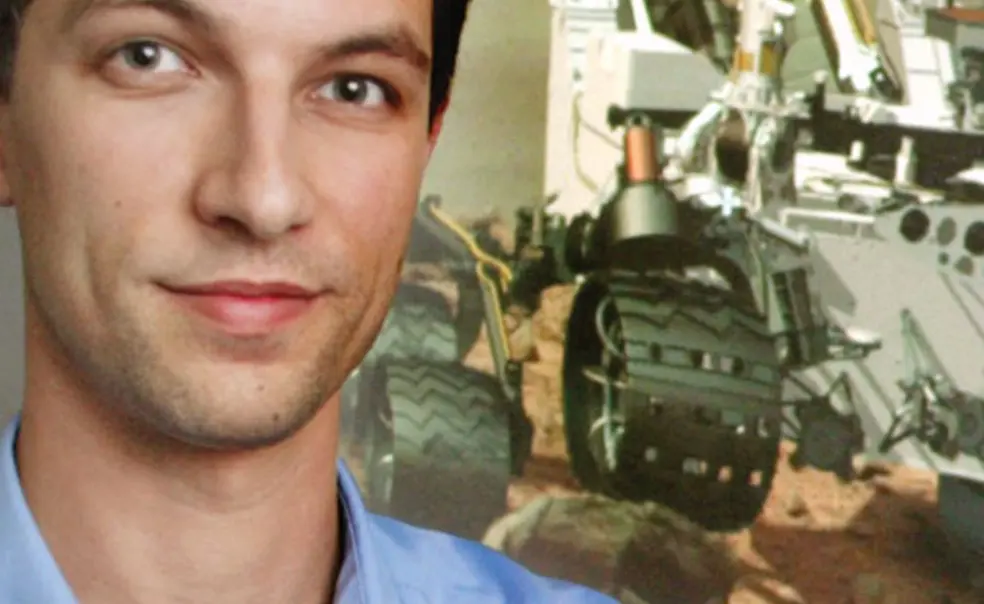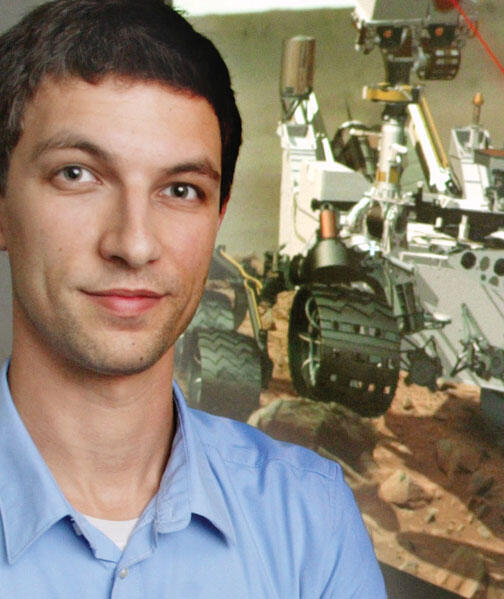Rover scientist Kevin Lewis, on the red planet
The Curiosity rover, which landed on Mars in August, was aptly named. Over the next two years, it will explore its landing site and the surrounding area, including 18,000-foot-high Mount Sharp, providing scientists with more information about the red planet than they ever have been able to obtain. Kevin Lewis, a postdoctoral associate research scholar in Princeton’s geosciences department, is spending the first 90 days of the rover’s two-year mission at the Jet Propulsion Laboratory in Pasadena, Calif., helping to select projects for the rover to execute.
The photos the rover sent back of Gale Crater [just south of the Martian equator] really were taken on a soundstage in Arizona, right?
(Laughs) Of course! It’s the same soundstage they used for the Apollo moon missions!
Kidding aside, Gale Crater does look a lot like deserts on Earth. Is that because it’s made of the same material?
It likely is very similar. The most common rock type on Mars is basalt, which is what is produced in many lava flows on Earth. On Mars, it will be interesting to look for chemical signs of alteration in that basalt. On Earth you find signs of sedimentary rocks that have been weathered out and turned into soils and other mineral types. We will be looking for that in Gale Crater and when the rover gets to Mount Sharp, which will take many months.
Why does it take so long to get there?
We have some limitations. One is safety. You only want to drive where you can see that there aren’t any large rocks or cliffs in front of you. The other is battery power. The rover uses the heat from a plutonium source to charge its battery. Once we drain the battery, we have to wait for it to recharge. That limits how far you can go in a day.
What is your schedule?
We’re synched to the Martian day. Totally by coincidence, the Martian day is almost exactly as long as an Earth day. It’s 24 hours, 39 minutes. We live and work on that Martian time, so our schedule shifts by about 40 minutes each day. We have to do that because we can only run the rover when it’s daylight on Mars. As soon as the sun goes down on Mars, the rover stops what it’s doing for the night, and we start planning for the next day’s activities.
What exactly do you do?
We spend a lot of time planning what the rover will image or analyze or drive to on a given day. There are 10 instruments and 17 cameras on board, but there are only a limited number of daylight hours and 300 scientists working on the project. Satisfying everyone can be a challenge. I work with the geologists, helping them reach a consensus and set priorities for what we want to study. I then help turn specific projects into a sequence of commands that we can send to the engineers who actually program the rover.
Is there any project you particularly want to undertake?
Mount Sharp, which is off in the distance, is a huge mountain of what appears to be sedimentary rock. We hope that if we can figure out how it formed, it will tell us a lot about the history of Mars over billions of years. Right now, we have no idea when things happened on Mars or for how long they happened. If we find evidence of water, for example, it’s going to be hard to tell if it was there for a day or for a billion years. By exploring the accumulated layers of sediment on Mount Sharp, we hope to be able to construct a geological timescale, which could be a powerful tool for understanding Martian history and climate.
Do you think you will find evidence of water or life?
I anticipate that we will find evidence of water. Finding evidence of life ... would be a pretty big deal, but I am totally agnostic about whether we will find it. One of the goals of the mission will be to look for organic carbon, so by the end of this mission, we should have a much better idea of the planet’s past and present habitability.
— Interview conducted and condensed by Mark F. Bernstein ’83













No responses yet